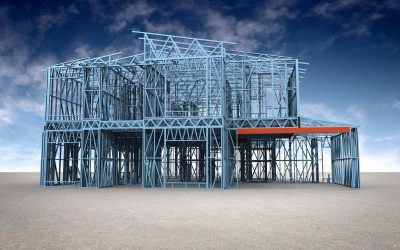The Rise of the Prefab Market: Part 2
Prefab construction has been in use for decades. But new reports are finding the method has become more popular in recent years as architects, engineers, designers, contractors, and buyers recognize its benefits.
- Blog Post
- April 2020
- Pekka Moilanen

A recent report released by Dodge Data & Analytics shows that prefab methods are increasingly being used for healthcare facilities, hotels, multifamily projects, and college buildings and dormitories. “Critical trends in the construction industry, such as shorter project schedules and workforce shortages, are several drivers of wider use of these methods, and technology — like building information modeling — is enabling increased use,” said Dodge Data upon announcing the report.
Modular Manufacturers: A Call to Scale and Optimization
Still, as McKinsey & Company stated in 2019, if prefab is going to achieve long-term staying power and create a sustainable alternative to traditional building techniques, some major changes will have to happen — starting with prefab product manufacturers.
First and foremost, as prefab becomes more widely used, manufacturers will need to be able to keep up with the increasing demand for their product. Today, many prefab manufacturers are already operating at capacity. These manufacturers will need to move to business models and facilities that will allow them to scale quickly while maximizing efficiency and quality — an effort that requires coordinating financing, acquiring or building new facilities, and moving to a higher operational standard.
To help achieve increased productivity and maximize the cost savings to compete with traditional onsite construction, prefab companies need to prioritize the following:
Achieve Economies of Scale
Prefab manufacturers will need adequate factory space as well as sufficient output to increase scale and, therefore, lower costs per unit. This investment in space will help ensure repeatability and volume savings on procurement.
Target the Value Chain
By partnering with owners and developers, prefab companies can win enough projects to justify larger factories, create a guaranteed pipeline of work, and grow their portfolios. All of these results will help sustain the productivity benefits provided by the prefab approach to manufacturing.
Optimize Design
Prefab construction requires a different way of thinking about design to account for production efficiencies, product standardization, mass customizations, and ease of transport and assembly. One of the major benefits of prefab design is its ability to maintain a consistent processing line, but manufactures also have to create pleasing and functional spaces for each occupant.
Leverage Technology and Data
Pairing prefab with Building Information Modeling (BIM) will allow manufacturers to seamlessly share project information, streamline the manufacturing process, improve construction scheduling, and estimate costs more precisely. They’ll also be able to use collected data to optimize just-in-time delivery to job sites.
Introduce Automation
Much like the auto industry, prefab companies can reach another level of productivity by introducing robotics and other automation technologies into the manufacturing process. Whether it’s a technology used for precision-cutting beams and panels or assembling prefab modules, increased automation will boost productivity across the board.
Improve Capabilities
Most prefab suppliers will need to invest in their employees, focusing on teaching new building skills and increasing expertise in design, manufacturing operations, and digital technologies. To do this, they may need to develop deeper and stronger partnerships with developers, construction firms, finance companies, and investors. And they’ll need to be able to successfully compete with other industries for the digital talent that’s needed.

A Prefab World: How Industry Players Will Need to Adapt
Major changes are not only relegated to the prefab industry. For this construction method to make a real impact, developers, investors, materials suppliers, and construction firms will also need to get on board — and adjust to support the shift.
Developers
Understandably, developers are intrigued by the potential benefits that come with modular construction, but they’re not sure how to make the leap in a way that guarantees reliable advantages.
A good place for developers to start is by focusing on the segments of their portfolio where volume, repeatability, and retained ownership come into play. Once identified, these products may need to be tailored for a modular approach (i.e. reducing the use of basements, changing room widths to maximum road transport limits, or minimizing variability between units) while remembering that a degree of customization will be crucial to satisfying both end customers and local authorities.
Investors
Disruption (a loss of productivity due to an interruption that affects overall efficiency) has been a longstanding challenge for the construction industry. To remedy this problem, the construction landscape will have to look very different and become an interesting sector for savvy investors. Smart investors should seek out the markets that are most likely to be disrupted and work to understand the trends, strategies, and capabilities that differentiate the winners from the losers. Prefab is one of those differentiating factors.
Materials Suppliers
As prefab gains a strong foothold, materials suppliers will face an inevitable shift in the products being purchased and who their customers are — a change that could impact their business if what they supply is no longer in high demand. That said, suppliers have an opportunity to thrive in the prefab space; if they have a knowledge of the industry and its efficiency benefits, they may have a head start over smaller engineering and construction firms.
Engineering and Construction Firms
In a prefab world, modules will still need to be assembled onsite, but construction may become a smaller and more commoditized piece of the value chain. To counter this risk, traditional engineering and construction firms can offer development, consulting, and planning services. They can also move into the business of building modules and, potentially, team up with module manufacturers.
Of course, custom projects won’t disappear (even in a more prefab world), so traditional firms can continue to thrive by setting their sights on highly complex projects that demand more onsite work. It will be critical for all businesses competing in the future of construction to accelerate digitization, be open to new collaborations, and keep operations lean.
A move toward prefab construction is on the horizon. Look at the current status of your company and assess how you can strategically make prefab a part of what you offer. Making the move could change the future of your business.
Related Stories
Cold-formed steel design-to-factory automation with Vertex BD
To fully realize the benefits of offsite manufacturing and modular construction, companies need a digital workflow that links the design office directly to fabrication.
Why Vertex is the leading CAD construction software
Best 3D construction software for professionals The construction industry is evolving rapidly, with factory-built construction gaining popularity due to its efficiency and precision. Companies that manufacture building components - such as walls, floors, and entire...
Best 3D construction software for professionals
Best 3D construction software for professionals 3D construction software has become a cornerstone of modern building projects, fundamentally transforming traditional construction practices. By enabling architects, engineers, and builders to create highly detailed,...




